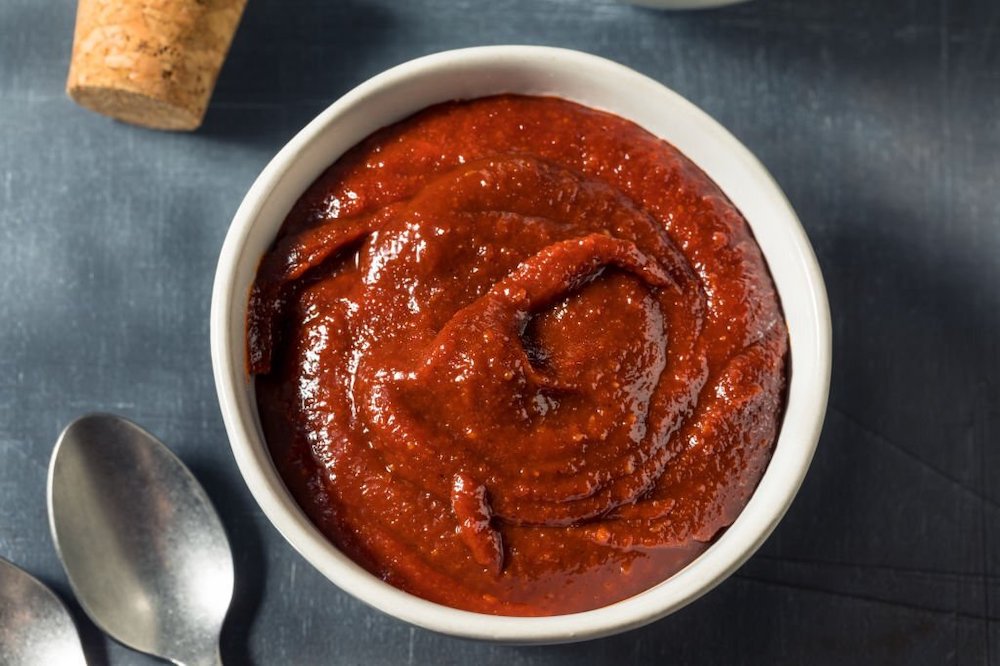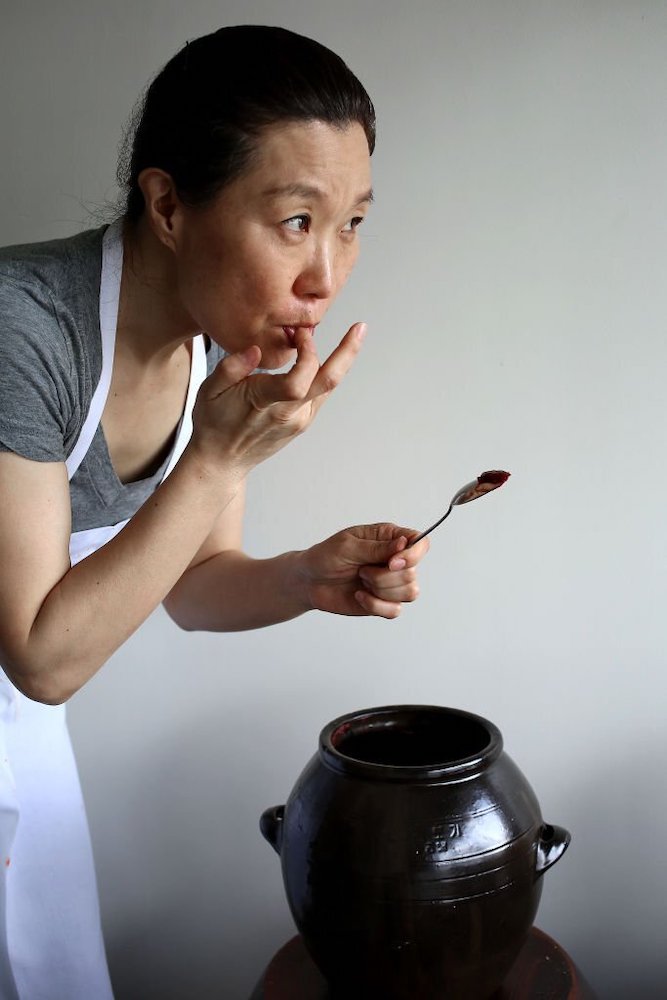Found some old gochujang in your fridge? Or maybe your mom gave you a tub that’s two years past the expiration date?
If you’re wondering if it’s still safe to use that gochujang, then you’ve come to the right place.
Gochujang (goh-choo-jang) is a thick red paste that puts the heat in your favorite Korean food. It’s made of red chili flakes, glutinous rice, fermented soybeans, and salt. All these ingredients make gochujang a burst of spicy, sweet, and salty tastes.
And did we tell you that it’s the backbone of Korean cuisine? This bright red paste often sold in tubs is found in countless Korean dishes. Bibimbap sauce, meat marinade, soup base, tteokbokki flavoring – the list is endless!
So it’s no wonder that gochujang lovers love to keep a tub in their fridge. But how long does gochujang last? Can you still it eat expired? Keep reading to save yourself from bad tummy aches!
Does gochujang go bad?

Sadly, your gochujang tub can’t last forever. It does have a long shelf life. But even if gochujang is fermented and has high salt content, it can still go bad if it’s not stored well.
But that doesn’t mean that you should strictly stick to the expiration date. Many Korean locals actually use their tubs even if it’s years past the expiry date.
So if gochujang goes bad but the expiry date isn’t so reliable, until when can you eat it?
How long does gochujang last?

Some gochujang users will tell you that this beloved red paste can only last up to two years. Whether unopened or kept in the fridge, they advise you to throw your tub away after 24 months of purchase.
But as most gochujang lovers will tell you, don’t trust the expiry date too much! As long as there’s nothing funky going on with the paste, it should still be safe to use it. If there’s no sign of spoilage, then you’re surely good to go.
Read More: 15 Korean Healthy Dishes You Should Eat More
How to know if gochujang is bad?

So how will you know if your gochujang is still safe to eat? Here are the signs of spoilage you should watch out for:
1. Sour smell
A weird smell is one of the surefire ways to tell if your gochujang has gone bad. It’s hard to describe what it smells like. But it definitely shouldn’t smell sour. If your paste smells like vinegar, discard the tub right away.
2. Color change
Fresh gochujang looks bright red, almost like crimson. So if it turned a darker red, don’t panic. Due to oxidation, it’s normal for the paste to change a bit in color – as long as it’s still a shade of red.
You can just scrape the top layer off to remove the oxidized portions.
But if you’re seeing tints of green, white, yellow, or other non-red colors on your paste, watch out! That’s definitely a telltale sign that it’s time to say goodbye to your gochujang.
3. Sour or bitter taste
Still unsure after smelling and inspecting your tub? Try tasting a teeny bit of the paste.
It’s also normal for gochujang taste to get stronger with time. That’s because it continued to ferment as it sat in your cupboard or fridge.
But it should never taste bitter or sour. Don’t hesitate to discard your tub if you catch a bit of sourness or bitterness in your paste.
4. Mold
Notice white bumps on the surface of your paste? That’s likely mold.
Like in any other food, mold is a dead giveaway for spoilage. If you see this on your paste, bid farewell to the entire tub right away. And no, scraping the mold off to keep the unaffected parts won’t help.
5. Runny texture
Fresh gochujang feels like sticky cooked glutinous rice. That means that the paste should be viscous and firm. If it looks runny or slimy, throw it away.
An old technique to check your paste’s consistency is by sticking a spoon through it. If the spoon stands, you’re likely good to go. But if the spoon falls, then it’s best to avoid using your paste.
6. Oil on the top layer
You should also watch out if oil has started to float on your gochujang’s surface. This is caused by the fermented beans in the paste. If you see this on your paste, we highly suggest discarding your tub.
Some will say that it’s still okay to use it like this. But still, best to keep safe since the tummy ache isn’t worth it!
7. Allergies and stomach aches
Ate an old gochujang that you suspect has gone bad? If you experienced allergies and stomach aches, your gut instinct might be right. That tub is likely spoiled.
That’s especially true if you’re not allergic to gochujang’s ingredients. So if you’re feeling a bit itchy or sick after your bibimbap, that expired gochujang is likely the culprit.
How to store gochujang properly?

So how do you store your gochujang properly to avoid spoilage?
The number one killer of gochujang pastes is heat. That’s why for unopened tubs, you should store it in a cool, dark place. Your closed cupboard or pantry should be ideal.
For used gochujang, it’s best to keep it refrigerated. And notice the plastic layer beneath the lid? Most Korean locals advise you to leave this cover on when you open the tub. In this way, the tub holds moisture better so that the paste doesn’t dry up.
Some even recommend covering your paste’s top layer with plastic wrap for added seal. You can also transfer your paste to an airtight container.
You May Also Like: How Does Gochujang Taste Like
Where to buy gochujang?

Gochujang is always sold in bright red, square tubs. You can find them practically anywhere in Korea. If you’re visiting the country. just drop by any market or grocery store.

But if you’re living overseas, you still won’t have a hard time finding this paste. Most Asian marts and Korean grocery stores carry tubs of our beloved gochujang. Even Walmart and your local supermarket must have this. You can probably find this in their condiment aisle.
No K-mart near your place? You can also order tubs on Amazon. Try these brands. All are authentic from Korea and have great reviews.
- CJ Haechandle gochujang is Korea’s best-selling gochujang from 2007-2015. It’s a classic taste, and you can’t go wrong with it.
- Sempio Hot Pepper Paste gochujang is another popular brand in Korea. It doesn’t use any preservatives, so you’re guaranteed an authentic Korean taste. This tub comes in a big 6-lb tub.
- Chung Jung One Hot Pepper Paste gochujang is made in Korea’s fermented paste capital. It uses brown rice instead of white. So there’s a kick of nutty flavor in this paste.
—
Because it’s fermented, it might seem like gochujang can never expire. But while it has a long shelf life, it can still go bad.
If you want it to last long, make sure that you refrigerate it and store it properly. And if your paste has been sitting for years, inspect it for signs of spoilage before consuming. You wouldn’t want a bad stomach ache from spoiled gochujang!
Wanna learn more about Korean food? Read our blog posts about why Koreans eat so much raw garlic and about Mukbang trend in Korea.

